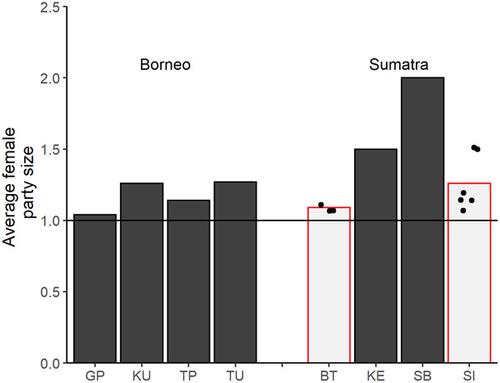当前位置:
X-MOL 学术
›
Am. J. Primatol.
›
论文详情
Our official English website, www.x-mol.net, welcomes your
feedback! (Note: you will need to create a separate account there.)
Grouping behavior of Sumatran orangutans (Pongo abelii) and Tapanuli orangutans (Pongo tapanuliensis) living in forest with low fruit abundance.
American Journal of Primatology ( IF 2.0 ) Pub Date : 2020-03-18 , DOI: 10.1002/ajp.23123 Tom S Roth 1 , Puji Rianti 2 , Gabriella M Fredriksson 3 , Serge A Wich 3, 4 , Matthew G Nowak 5, 6
American Journal of Primatology ( IF 2.0 ) Pub Date : 2020-03-18 , DOI: 10.1002/ajp.23123 Tom S Roth 1 , Puji Rianti 2 , Gabriella M Fredriksson 3 , Serge A Wich 3, 4 , Matthew G Nowak 5, 6
Affiliation

|
In contrast to the African great apes, orangutans (Pongo spp.) are semisolitary: Individuals are often on their own, but form aggregations more often than expected by chance. These temporary aggregations provide social benefits such as mating opportunities. When fruit availability is high, costs of aggregating should be lower, because competition is less pronounced. Therefore, average party size is expected to be higher when fruit availability is high. This hypothesis would also explain why orangutans in highly fruit-productive habitats on Sumatra are more gregarious than in the usually less productive habitats of Borneo. Here, we describe the aggregation behavior of orangutans in less productive Sumatran habitats (Sikundur and Batang Toru), and compare results with those of previously surveyed field sites. Orangutans in Sikundur were more likely to form parties when fruit availability was higher, but the size of daily parties was not significantly affected by fruit availability. With regard to between-site comparisons, average party sizes of females and alone time of parous females in Sikundur and Batang Toru were substantially lower than those for two previously surveyed Sumatran sites, and both fall in the range of values for Bornean sites. Our results indicate that the assessment of orangutans on Sumatra as being more social than those on Borneo needs revision. Instead, between-site differences in sociality seem to reflect differences in average fruit availability.
中文翻译:

苏门答腊猩猩(Pongo abelii)和Tapanuli猩猩(Pongo tapanuliensis)的分组行为生活在水果丰度低的森林中。
与非洲大猩猩相反,猩猩(Pongo spp。)是半孤独的:个体通常是一个人,但比偶然地形成聚集的机会更多。这些临时聚集提供诸如交配机会之类的社会利益。当水果供应量很高时,由于竞争不太明显,因此汇总成本应更低。因此,当水果供应量很高时,平均聚会人数预计会更高。该假设还可以解释为什么苏门答腊高产水果的栖息地中的猩猩比婆罗洲通常生产力较低的生境中的猩猩更合群。在这里,我们描述了猩猩在生产力较低的苏门答腊生境(Sikundur和Batang Toru)中的聚集行为,并将结果与以前调查的实地进行了比较。当水果供应量较高时,西昆杜尔的猩猩更可能成立聚会,但日常聚会的规模并不受水果供应量的显着影响。关于站点间比较,西昆杜尔和巴塘托鲁的女性平均聚会人数和独居女性的单身时间显着低于先前调查的两个苏门答腊站点,而且都在婆罗洲站点的数值范围内。我们的结果表明,对苏门答腊猩猩的评估比婆罗洲对猩猩的评估更为社会化。相反,站点之间的社会差异似乎反映了平均水果供应量的差异。Sikundur和Batang Toru的女性平均派对人数和独居女性的独处时间显着低于先前调查的两个苏门答腊站点,并且都在婆罗洲站点的数值范围内。我们的结果表明,对苏门答腊猩猩的评估比婆罗洲对猩猩的评估更为社会化。相反,站点之间的社会差异似乎反映了平均水果供应量的差异。Sikundur和Batang Toru的女性平均派对人数和独居女性的独处时间显着低于先前调查的两个苏门答腊站点,并且都在婆罗洲站点的数值范围内。我们的结果表明,对苏门答腊猩猩的评估比婆罗洲对猩猩的评估更为社会化。相反,站点之间的社会差异似乎反映了平均水果供应量的差异。
更新日期:2020-03-18
中文翻译:

苏门答腊猩猩(Pongo abelii)和Tapanuli猩猩(Pongo tapanuliensis)的分组行为生活在水果丰度低的森林中。
与非洲大猩猩相反,猩猩(Pongo spp。)是半孤独的:个体通常是一个人,但比偶然地形成聚集的机会更多。这些临时聚集提供诸如交配机会之类的社会利益。当水果供应量很高时,由于竞争不太明显,因此汇总成本应更低。因此,当水果供应量很高时,平均聚会人数预计会更高。该假设还可以解释为什么苏门答腊高产水果的栖息地中的猩猩比婆罗洲通常生产力较低的生境中的猩猩更合群。在这里,我们描述了猩猩在生产力较低的苏门答腊生境(Sikundur和Batang Toru)中的聚集行为,并将结果与以前调查的实地进行了比较。当水果供应量较高时,西昆杜尔的猩猩更可能成立聚会,但日常聚会的规模并不受水果供应量的显着影响。关于站点间比较,西昆杜尔和巴塘托鲁的女性平均聚会人数和独居女性的单身时间显着低于先前调查的两个苏门答腊站点,而且都在婆罗洲站点的数值范围内。我们的结果表明,对苏门答腊猩猩的评估比婆罗洲对猩猩的评估更为社会化。相反,站点之间的社会差异似乎反映了平均水果供应量的差异。Sikundur和Batang Toru的女性平均派对人数和独居女性的独处时间显着低于先前调查的两个苏门答腊站点,并且都在婆罗洲站点的数值范围内。我们的结果表明,对苏门答腊猩猩的评估比婆罗洲对猩猩的评估更为社会化。相反,站点之间的社会差异似乎反映了平均水果供应量的差异。Sikundur和Batang Toru的女性平均派对人数和独居女性的独处时间显着低于先前调查的两个苏门答腊站点,并且都在婆罗洲站点的数值范围内。我们的结果表明,对苏门答腊猩猩的评估比婆罗洲对猩猩的评估更为社会化。相反,站点之间的社会差异似乎反映了平均水果供应量的差异。











































 京公网安备 11010802027423号
京公网安备 11010802027423号